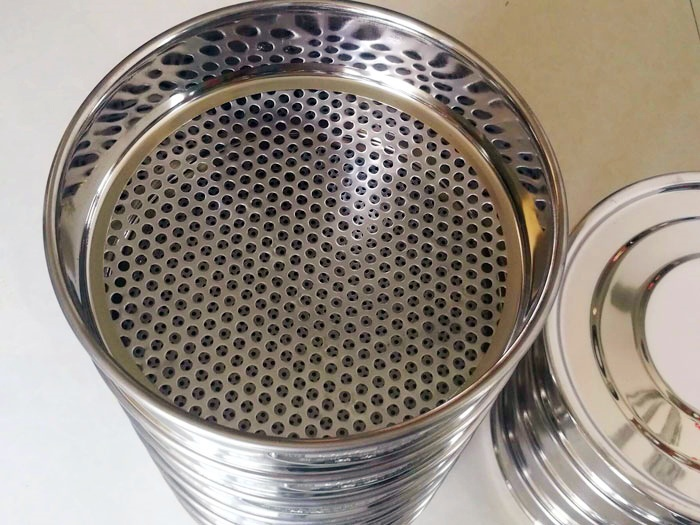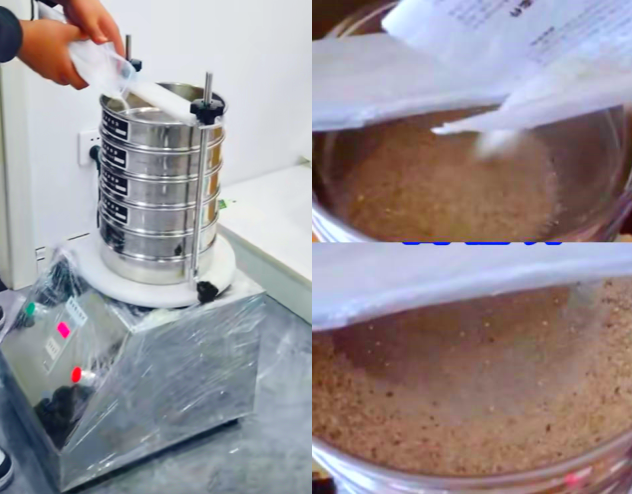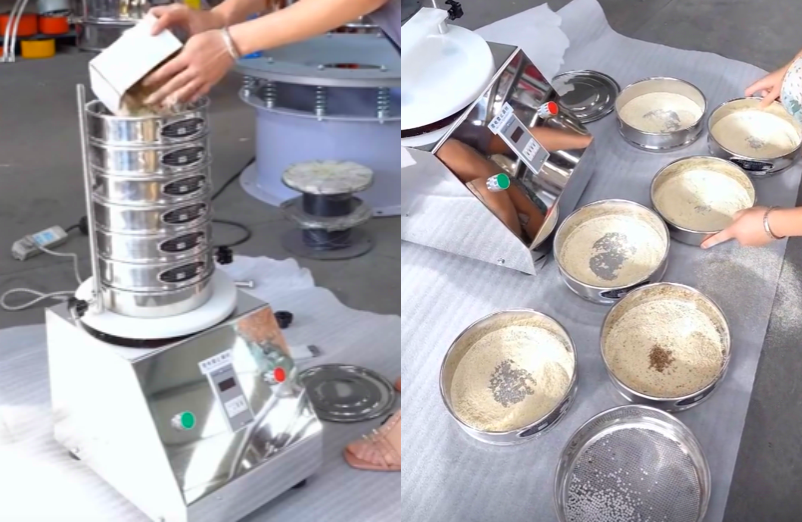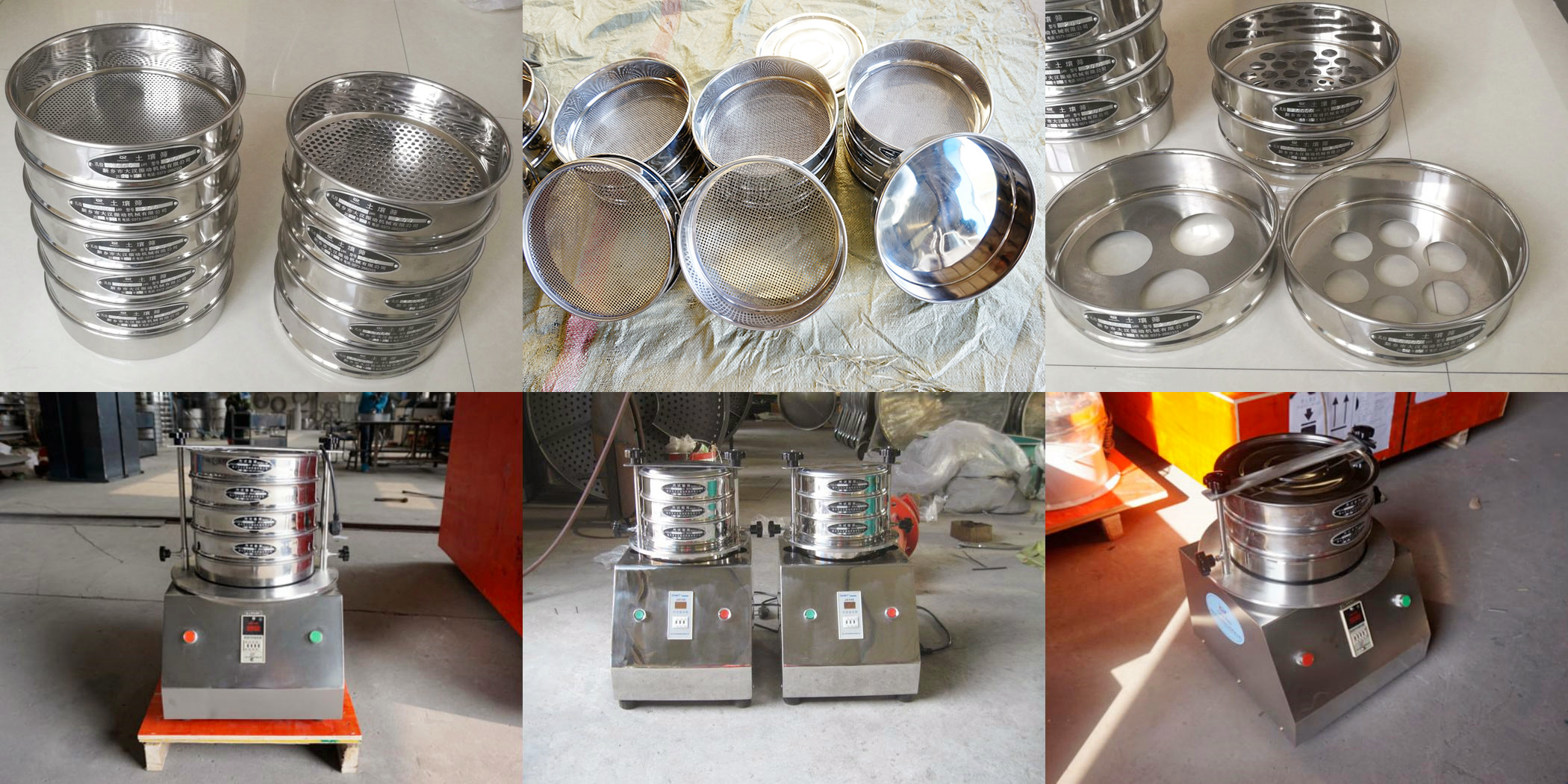Thursday December-04 2025 10:46:52
Chemical material standard laboratory vibrating sifter is a screening equipment dedicated to experimental analysis and particle size detection of chemical raw materials. It is suitable for fine grading of the particle size of powdered, granular or crystalline chemical materials. Chemical materials have the characteristics of diverse types, large particle size span, easy to absorb moisture or easy to adhere. Therefore, the screening process has high requirements for screen specifications, vibration mode and screening accuracy.

The equipment is usually equipped with a standard screen frame with a diameter of Φ200mm or Φ100mm, which can be stacked 1 to 8 layers. The screen aperture ranges from 20 microns to 2 mm. It provides stable screening through electromagnetic or eccentric vibration devices, which helps the material to be fully dispersed and screened on the screen surface. By adjusting the screening time and amplitude, the screening error caused by powder agglomeration or static electricity can be effectively avoided.

In the application of standard laboratory vibrating sifters for chemical materials, the screen type is a key factor affecting the screening accuracy and efficiency. According to the manufacturing process and structural characteristics of the screen, it can be divided into woven mesh screen, punched plate screen and electroformed screen
Woven mesh screen: woven by metal wire (such as stainless steel wire, copper wire) or non-metallic wire (such as nylon wire), and square, rectangular or special-shaped screen holes are formed by crossing the longitude and latitude lines
Features: The screen hole size range is wide (usually 0.025mm to several millimeters), suitable for powders, particles and chemical materials with low viscosity

Punched plate screen: Punch out round, square or strip holes on metal plates (such as stainless steel plates, aluminum plates), the hole wall is perpendicular to the plate surface, the screen hole has high precision and strong rigidity
Features: Suitable for processing large particles, high hardness or strong impact chemical materials, suitable for coarse-grained materials, high-hardness particles and high-temperature environment materials

Electroformed screen: Metal is deposited on a conductive substrate through the electroforming process to form a precision screen, and the screen hole size can be accurate to the micron level (such as 5μm-1mm)
Features: The screen hole size accuracy is extremely high (error ±1%), suitable for screening of nano- to micron-level fine chemical materials and special-shaped particles, such as needle-shaped crystals and flake pigments

|
Screen type |
Typical aperture range |
Applicable material characteristics |
Chemical application scenarios |
Cost comparison |
|
Woven mesh screen |
0.025mm-several millimeters |
Medium particle size, low hardness, non-corrosive |
Paint fillers, plastic particles, conventional powder detection |
Low |
|
Perforated plate screen |
3mm-50mm |
Large particles, high hardness, high temperature or impact |
Ore coarse screening, ceramic raw materials, metal powder classification |
Medium |
|
Electroforming screen |
5μm-1mm |
Nano/micron level, high purity, fine classification |
Catalyst, electronic grade powder, pharmaceutical raw material detection |
High |
Chemical materials have complex compositions and different characteristics. The screening process often faces problems such as uneven particle size, easy agglomeration, and corrosion equipment. The chemical material standard laboratory vibrating sifter adopts adjustable vibration parameters, such as the number of vibrations, the number of rotations and the amplitude, which can be precisely adjusted according to the material characteristics.

For example, for nano-scale catalyst powders that are easy to agglomerate, high-frequency and low-amplitude vibration can be used to achieve dispersed screening; the multi-layer screen design can complete multiple particle size classifications at one time, solving the problem of large particle size span of chemical materials. In addition, some vibrating screens are equipped with explosion-proof and anti-corrosion materials (such as stainless steel screen bodies), which can safely handle flammable, explosive or corrosive materials to avoid safety hazards and equipment damage.
In practical applications, the chemical material standard laboratory vibrating sifter relies on high-precision screens and stable operation to ensure reliable screening results. For example, the electroformed screen can achieve micron-level screening to meet the particle size detection requirements of fine chemical materials; the elasticity and self-cleaning ability of the woven mesh screen can reduce material blockage and improve screening efficiency.
At the same time, automation functions (such as timed start and stop, data recording) can reduce manual errors, improve detection efficiency, provide key technical support for chemical material research and development, production and quality control, and ensure the stability and consistency of chemical products.
|
Model |
Sieve frame diameter |
Number of layers range |
Sieve mesh specification range |
Power supply |
Applicable sample type |
|
DH-200 |
Φ200mm |
1~8 layers |
20μm~20mm |
AC220V |
Chemical powder, granules, resin, etc. |
|
DH-300T |
Φ300mm |
1~6 layers |
38μm~10mm |
Large-particle chemical raw materials, fillers |
|
|
DH-100 |
Φ100mm |
1~5 layers |
45μm~5mm |
Small sample high-value chemical screening |
|
|
DH-ZSY |
Φ200mm |
1~7 layers |
20μm~5mm |
Catalysts, nanomaterials, silicon powder |
|
|
DH-450 |
Φ400mm |
Single or double layer |
≥75μm (coarse screen) |
Fast coarse screening, suitable for batch samples |
|
|
DH-TZD |
Φ200mm |
1~6 layers |
25μm~2mm |
Fine chemicals, sensitive materials |

The chemical material standard laboratory vibrating sifter can be used in a variety of chemical material research and testing scenarios. In the production and development of coatings, pigment powders such as titanium dioxide are screened to ensure uniform particle size and avoid problems such as agglomeration and uneven coating of coatings due to excessively large particles; in the rubber industry, reinforcing agents such as carbon black and white carbon black can be screened to ensure the mechanical properties and wear resistance of rubber products.
For the plastics industry, plastic granular raw materials can be screened to remove unqualified large particles or agglomerated materials, and improve the molding quality and appearance quality of plastic products; in the field of fine chemicals, catalysts, additives and other tiny particle chemical materials are accurately graded to ensure their activity and dispersibility in chemical reactions. For example, the particle size control of molecular sieve catalysts directly affects the catalytic efficiency.
DaHan Machinery is one of the earliest manufacturers of laboratory vibrating sieves in China, possessing significant technological expertise and product coverage in the field of chemical raw material screening equipment. They produce Φ200 mm series, full-height frame sieves of approximately 50 mm, low-height frame sieves of approximately 25 mm, and Φ75 mm series, with sieve plates conforming to specifications and high mesh precision. These sieves can be matched with impact sieves, ultrasonic test sieves, and top-impact sieves. Their Chemical Material Standard Laboratory Vibrating Sifter is used for particle size analysis and quality testing of fine particles, micro powders, and granular chemical raw materials, and is widely used in chemical enterprises, research institutes, university laboratories, and other institutions.

Adapt to various material characteristics: Efficiently handle chemical materials that are easy to agglomerate, easy to absorb moisture, and have a large particle size span, such as calcium carbonate, silicon powder, synthetic resin, catalyst powder, etc.
Support non-standard customization: The number of screen layers, screen aperture, sealing structure, etc. can be customized according to user needs to meet the use scenarios of different chemical raw materials and experimental processes
What is the wet sieving process?
Wet sieving process is a sieving process assisted by a liquid (usually water or a solution containing a dispersant) to more effectively...
Fines content tester can be defined as an instrument used to quantitatively determine the content of fines powder components of a specific fineness...
Micro silica powder particle size analysis test sieve
Micro silica powder, also known as silica fume, is an ultrafine active silica material with a very small particle size, usually between 0.1-0.3 microns, which...
Agricultural gruesos Test sieves
Agricultural gruesos test sieves are experimental equipment used for particle size analysis, grading and testing of agricultural soil, gruesos...
Stainless steel frame and woven cloth
The test sieve is a laboratory equipment used for particle size analysis. Its core components usually include a stainless steel frame and woven cloth (also called a sieve)...
Dec 04, 2025
Chemical Material Standard Laboratory Vibrating Sifter
Chemical Material Standard Laboratory Vibrating Sifter is a device used to determine the particle siz...
Dec 02, 2025
vibration screening test sieve
Vibration screening test sieve separates materials through vibration, thereby determining the particl...
Dec 02, 2025
size sieve for soil is made of stainless steel and can sieve out dust and soil. The fine sieve sizes ...
Nov 29, 2025
material particle size test sieve
material particle size test sieve helps generate a reliable material particle size distribution throu...
![]()
Then we look forward to hearing from you
Contact Us
Industrials
Yanjin county forest park gate to the west 1000 meters north road sitemap
